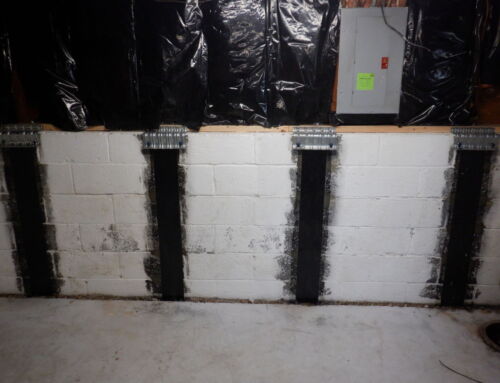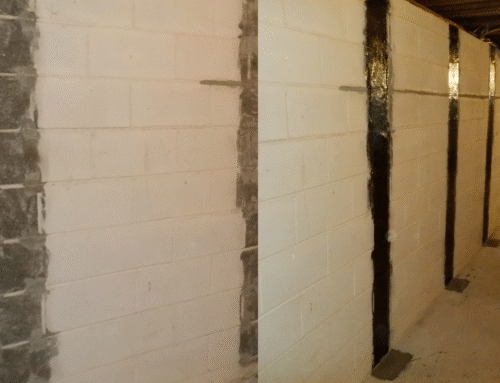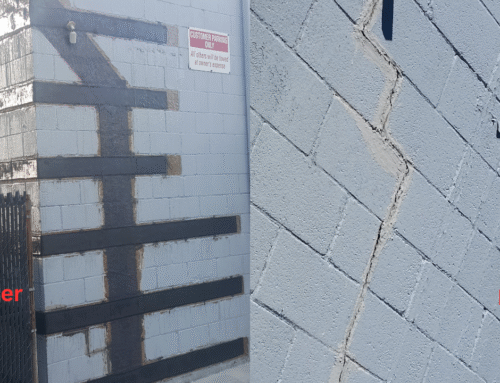IN THIS ARTICLE
This is how we repaired a cracked Basement Wall with Carbon Fiber Straps in Bridgewater, NJ
At Concrete Chiropractor, we recently helped a homeowner in Bridgewater, NJ, who noticed their basement wall starting to bow inward and develop visible cracks. This is a common problem across New Jersey due to soil movement, hydrostatic pressure, and seasonal changes. Cracked or leaning basement walls are not only concerning to look at, but can also weaken the structure if ignored. Fortunately, our proven carbon fiber wall strap repair method offers a permanent, non-invasive fix.
How the Homeowner Found Us
The homeowner discovered us while searching online for “cracked basement wall repair in New Jersey”, along with similar terms like “bowing foundation wall repair” and “basement wall reinforcement near me.” They came across our website and saw that we specialize in non-invasive carbon fiber basement wall repairs.
After reaching out for a free consultation, we asked them to send clear photos of the affected areas. Our process starts by reviewing the images clients send. From there, we evaluate the condition, determine the extent of the wall movement, and provide a free estimate before any work begins.
What We Found From the Photos
The pictures showed a typical case of a bowing concrete block basement wall. Several horizontal and stair-step cracks were visible, and some sections were slightly leaning inward. These signs told us that soil pressure and moisture were pushing against the exterior side of the foundation.
In New Jersey, this happens often after periods of heavy rain or during winter, when water freezes and expands in the soil. The constant pressure causes the wall to move inward over time. Fortunately, this level of movement can be permanently stabilized using carbon fiber reinforcement straps.
Why Carbon Fiber Straps Are the Best Solution
Carbon fiber has become the go-to technology for repairing cracked or bowing basement walls. It’s lightweight, non-corrosive, and stronger than steel when bonded to concrete. Most importantly, the repair process doesn’t require any major excavation or disruption. Once installed, the straps hold the wall firmly in place and prevent any further inward movement.
Our system works by applying these straps vertically across the damaged area. Each strap ties the wall back to its original position and distributes the external pressure evenly. Once completed, the straps blend with the wall and can be painted over, leaving a clean finish.
Step-by-Step: How We Repaired the Basement Wall with Carbon Fiber Straps
- Surface Preparation
Before installing anything, we ensured the wall was clean and ready. We instructed the homeowner to clear the area so our technicians could work freely. On the repair day, our team ground the wall surface where each carbon fiber strap would be placed. This step removes paint, debris, and any loose materials, ensuring a strong bond with the epoxy. - Crack Sealing
Next, all visible cracks were sealed using a fast-setting, high-strength hydraulic cement. This prevents moisture from seeping into the wall and strengthens the concrete surface. Proper sealing is key to the durability of the repair. - Marking Strap Locations
We measured and marked vertical lines along the wall, typically spacing the straps about four feet apart. Depending on the wall’s stress level, we sometimes place the straps closer together for added reinforcement. - Applying Structural Epoxy
A structural-grade epoxy resin was applied along each marked line. This adhesive acts as the bonding agent between the concrete and the carbon fiber strap. - Installing Carbon Fiber Straps
Once the epoxy was ready, we carefully placed the carbon fiber straps onto the wall, pressing them firmly to ensure full contact. These straps are extremely strong and flexible during installation but harden once the epoxy cures. - Finishing the Wall
We then applied a final coat of epoxy over each strap. This seals the surface completely and makes the straps nearly invisible once painted. The homeowner appreciated that the final look was clean and could easily be finished with regular wall paint.
The Result
After the installation, the basement wall was fully stabilized. The homeowner now has peace of mind knowing that the wall will no longer move or crack further. Unlike temporary fixes, carbon fiber straps permanently reinforce the structure and prevent additional inward bowing caused by soil pressure or water buildup.
Why We Don’t Require On-Site Inspections First.
Some homeowners are surprised to learn that we don’t visit properties for initial inspections. Instead, we rely on detailed photos sent by clients first. This allows us to quickly assess the situation, recommend the best repair method, and provide accurate estimates without unnecessary travel or costs. Then we go on-site, take measurements, and consult with a structural engineer to complete the repair. With decades of experience, we can identify most structural issues accurately from clear images.
Final Thoughts
Cracked and bowing basement walls are more than cosmetic problems—they are signs that your foundation is under stress. Ignoring them can lead to serious structural issues later. Carbon fiber strap repair is one of the most reliable and cost-effective solutions available today for stabilizing basement walls.
At Concrete Chiropractor, we’ve been fixing cracked and bowing concrete walls and floors across New Jersey and Eastern Pennsylvania for over 25 years. Our goal is to make your home safe, stable, and worry-free using trusted, proven methods.
If you notice cracks or bowing in your basement walls, contact us today for a free photo evaluation and estimate. We’ll help you understand the problem and provide the best long-term repair option for your foundation.
- How We Repaired a Cracked Basement Wall in Raritan, NJ - October 26, 2025
- How We Repaired a Bowing Concrete Block Wall in Hillsborough, NJ - October 25, 2025
- How We Fix a Cracked Concrete Block Wall at B & G Gulf in Holmdel, NJ - October 23, 2025
